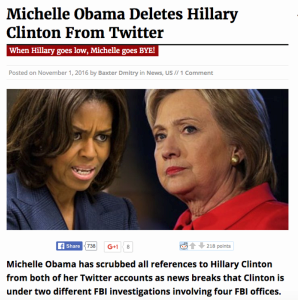How to identify fake news and prevent it from spreading.
While the internet is a wonderful tool for expressing your opinion instantly, it’s becoming increasingly apparent that people are quick to confuse opinions with hard, proven facts, thus spreading fake news. Many, many websites are fueled on attracting clicks as an almost blind reaction. Furthermore, have you ever shared a piece that you hadn’t even entirely read? When you decide to share, or “like” a story, you should maybe think twice about what it’s talking about and if it’s worth sharing. Our web is only as good as the content we put out and propagate.
Fake news: what the heck is it, actually?
Many people have been using the term fake news for the last few years, but do they actually know what it looks like? The term has been used so amorphously that it begs a more direct examination. Sensationalist fake news is often used to generate clicks onto a webpage to improve ad revenue. It has also been used to influence public thought. Though you would probably chuckle and dismiss the supermarket tabloids proclaiming the existence of bat boy, the internet can be a bit more subtle. What’s one to do when even reputable organizations like the New Yorker rely on satirical news columns to obtain knee-jerk clicks? By studying up a bit, humans can hopefully become more adept at spotting fakes online. Let’s check out a few fantastic examples of fabricated news flashes.
Was there a human head transplant?
No, indeed, there wasn’t, the Guardian reports. After Italian doctor Sergio Canavero claimed to be undertaking such an operation, stories about a successful head transplant circulated on various fake news sites. If you saw this item, would you click on it? Here you have a nice little nugget of fake news.

Source:https://newsexaminer.net/lifestyle/health/worlds-first-head-transplant-a-success/
Did Michael Jordan leave Nike?
Some fake news is clearly preposterous, while some of it rests slightly closer to reality. In the wake of controversial quarterback Colin Kaepernick becoming the new face of a big Nike campaign, this item about MJ gained a lot of traction. Guess what? Politifact debunked it.
 Source:https://trumpbetrayed.us/breaking-michael-jordan-resigns-from-the-board-at-nike-takes-air-jordans-with-him/
Source:https://trumpbetrayed.us/breaking-michael-jordan-resigns-from-the-board-at-nike-takes-air-jordans-with-him/
Did Michelle Obama forsake Hillary Clinton on Twitter?
Sorry, gossipers, no she didn’t. But this item was even reported on mainstream Fox news. This is an example of the now notorious fake news that was propagated to influence the 2016 US election.
 Source: Your News Wire (now deleted)
Source: Your News Wire (now deleted)
Fool me once: Fake news in 2016
After the 2016 US election, much controversy arose over the role that the private company Cambridge Analytica played in influencing public opinion via social media. What happened here was not so much a “hack”, as was reported in the mainstream news, but a harnessing of information that users themselves gave (albeit mostly unwittingly) to Facebook. This led to the psychological targeting of people with ads that were more or less propaganda with a scant if any connection to reality. Fake news was shared across all age groups, but especially among those aged 65 and over.
Don’t fool me again: Governments push back
Just as free speech can be used for good or ill, the increasing democratization of expression on the internet is also good and bad. Since the 2016 US election, many politicians have proposed legislation to limit election interference on the internet, i.e. fighting the spread of fake news. But as the 2018 Facebook hearings before congress demonstrated, many politicians struggle to fully grasp the beast of internet regulation. And as the 2020 US election race gets closer, the state of this fight remains insufficient. As Alexandre Alaphilippe of EU Disinfolab said, “They’re fighting tomorrow’s disinformation with yesterday’s tools.” The good news is that smart push-back can come from the bottom up. In short, the issue is twofold: you should be scrupulous about what you read online, and you should also limit the ways sites like Facebook can be used to psychologically target you. Learn more about Facebook settings here.
Think before you share: six tips
Here are some things to consider when you’re boogie boarding around the digital ocean and are confronted with a snappy item you may want to share.
-
What source does the piece come from? Have you heard of it, and does it appear to be reputable? Is the piece serious or is it intended as satire?
-
Is it more than a catchy headline and is that headline accurate to the presented story? See if there is actually a story there at all and get suspicious if the item is short and seems based on nothing.
-
Is the piece exaggerating fears that seem strangely close to your own? You may have been targeted based on your search history and are now being manipulated over to false articles created to scare you.
-
Is it current? Check the date to make sure you’re not ready to flip your wig (and someone else’s) over two-year old news, whether real or fake.
-
Be careful what you click on in the article — if there are links, they could be phishing you or sending you to a site that could infect your device if they aren’t legit.
-
Check the item on reputable sites like factcheck.org, which are dedicated to debunking internet falsehoods.
Think you’re ready to spot fake news? Try this fun quiz.
If social media doth grow and prosper on the spread of compelling content, let that content not be false. We’re sure if the founding fathers were still around, they would’ve said something like that. While you don’t always have time to research everything you come across, if you can apply even a few of these tips, it should make for a better experience online. The online ecosystem can improve when people spread pieces that add value (such as this one, of course).